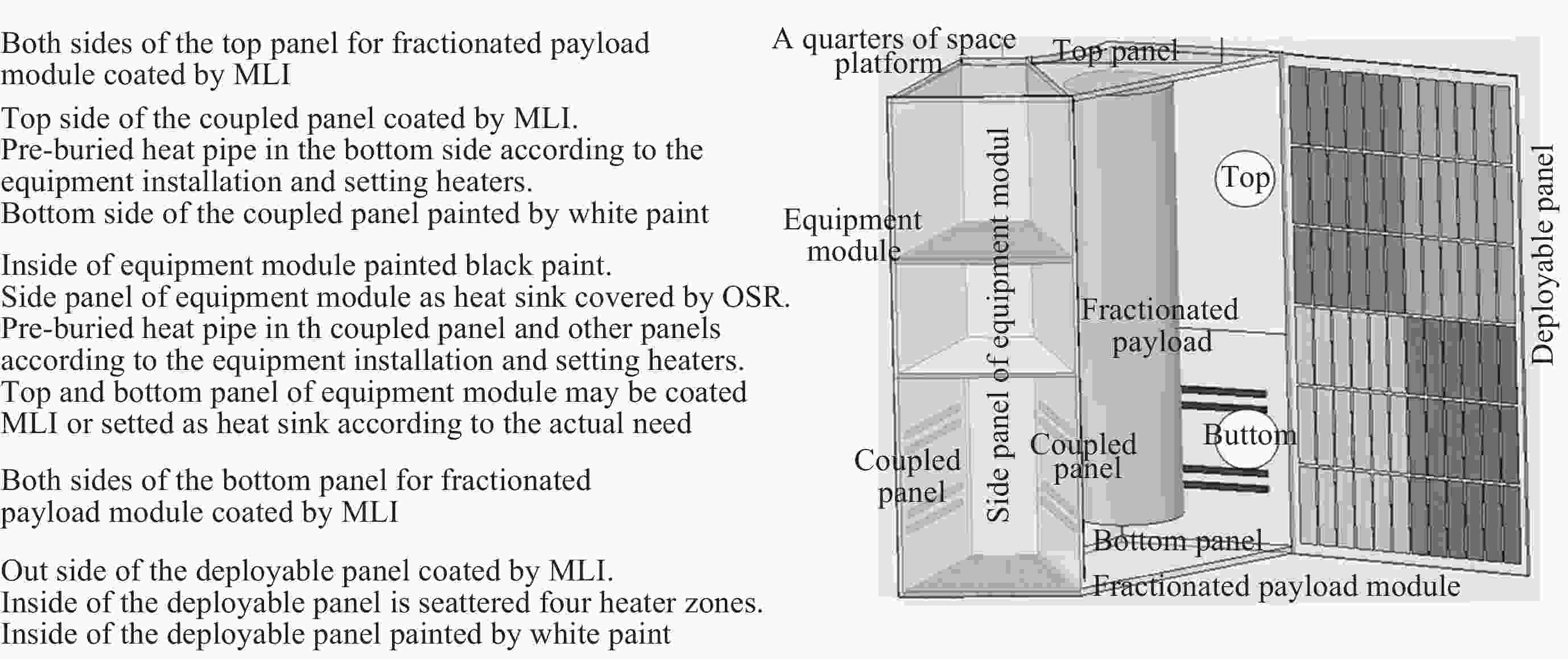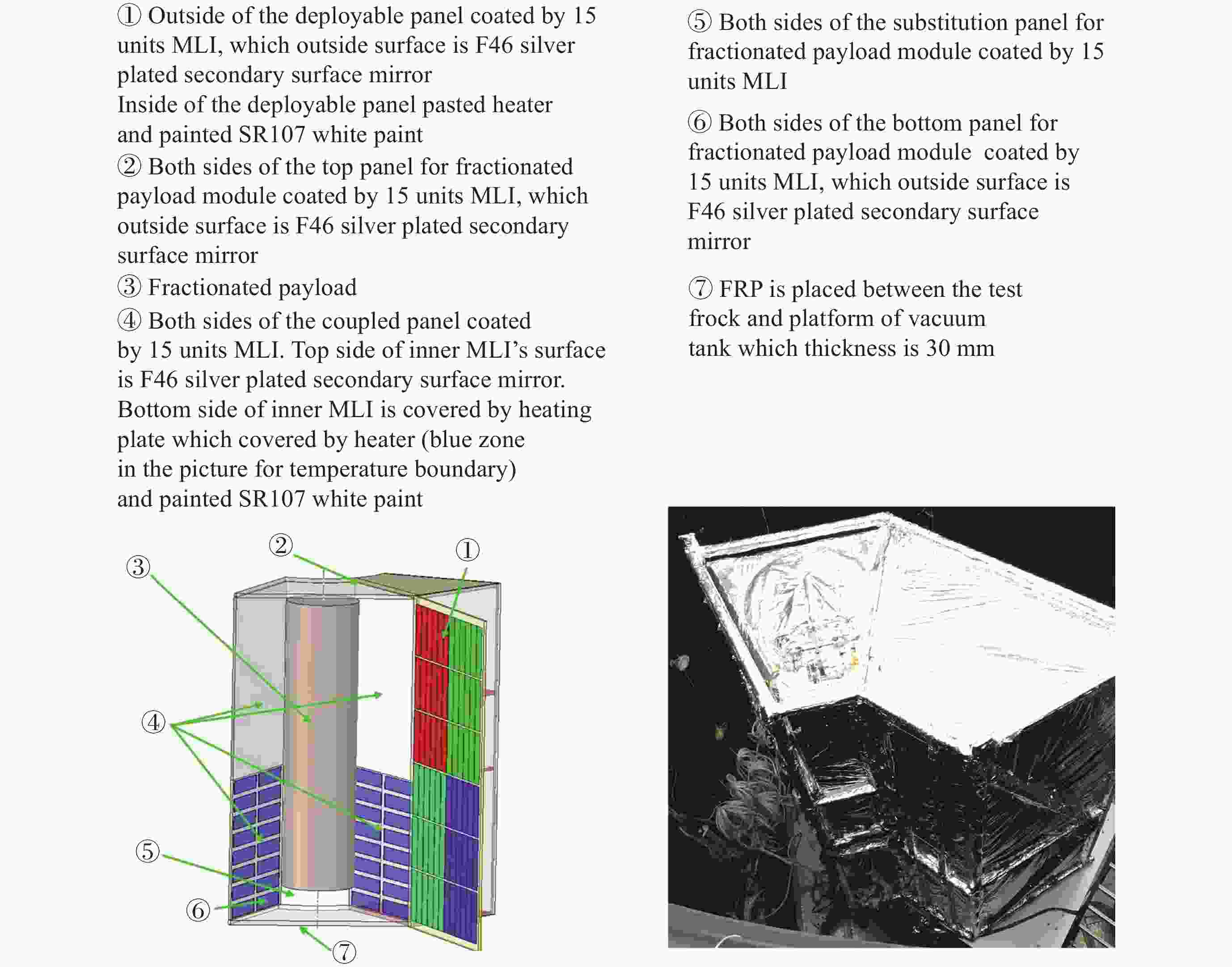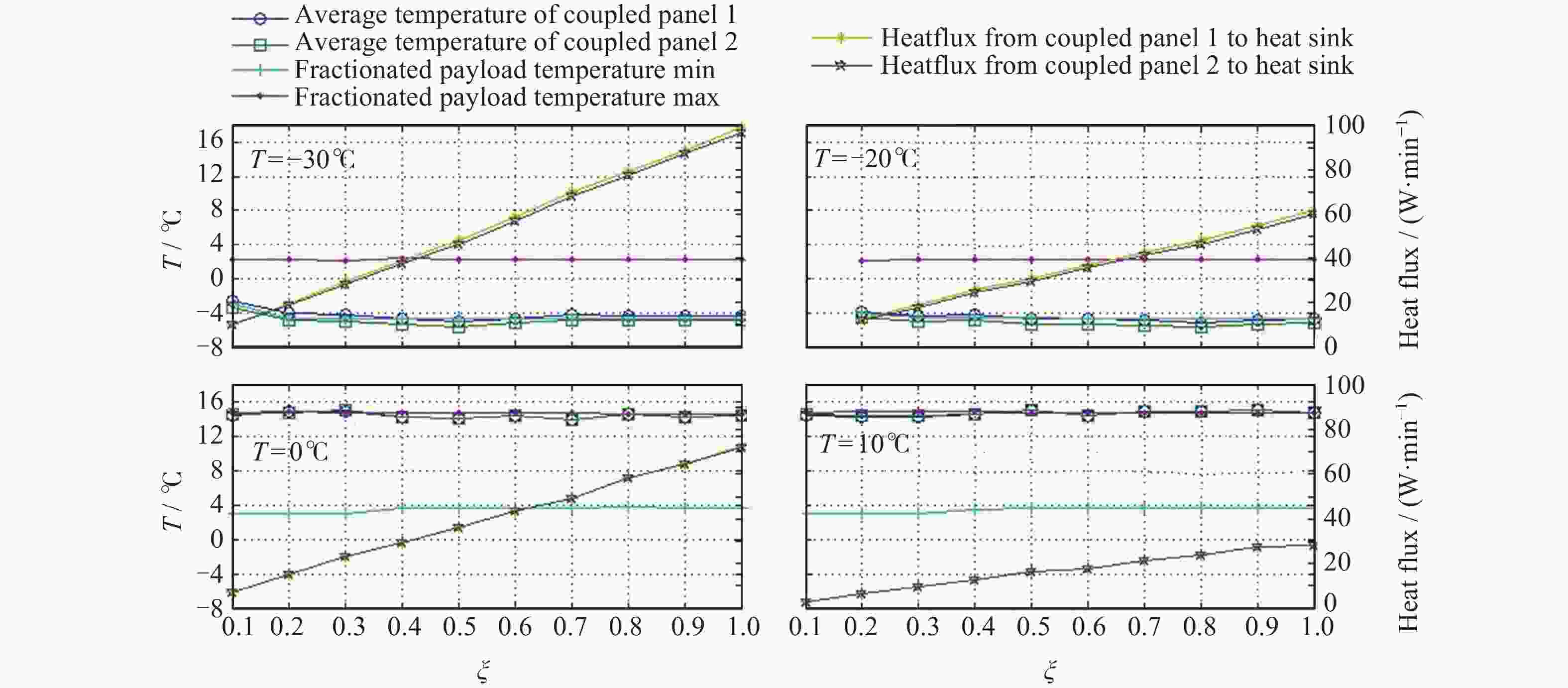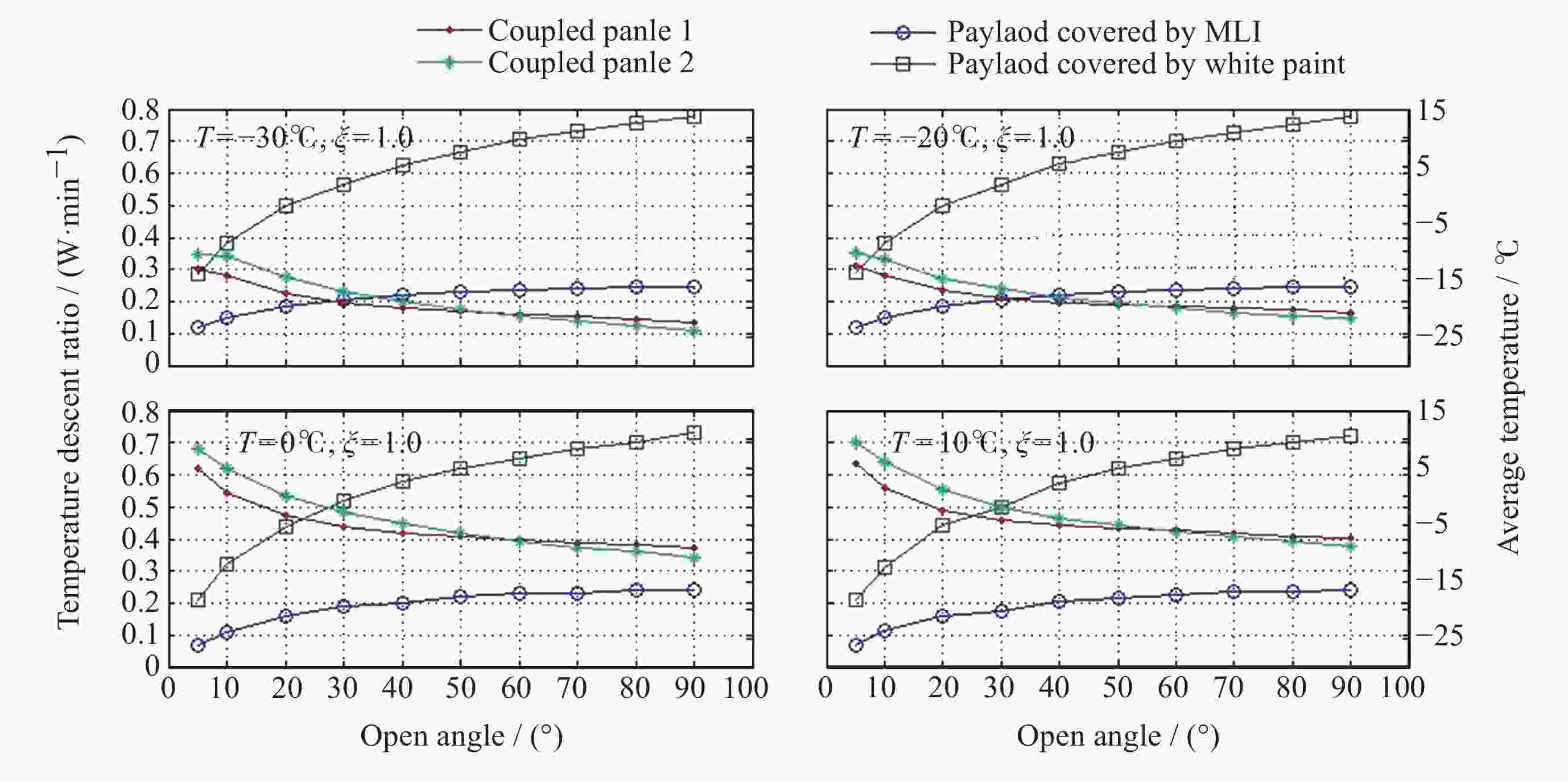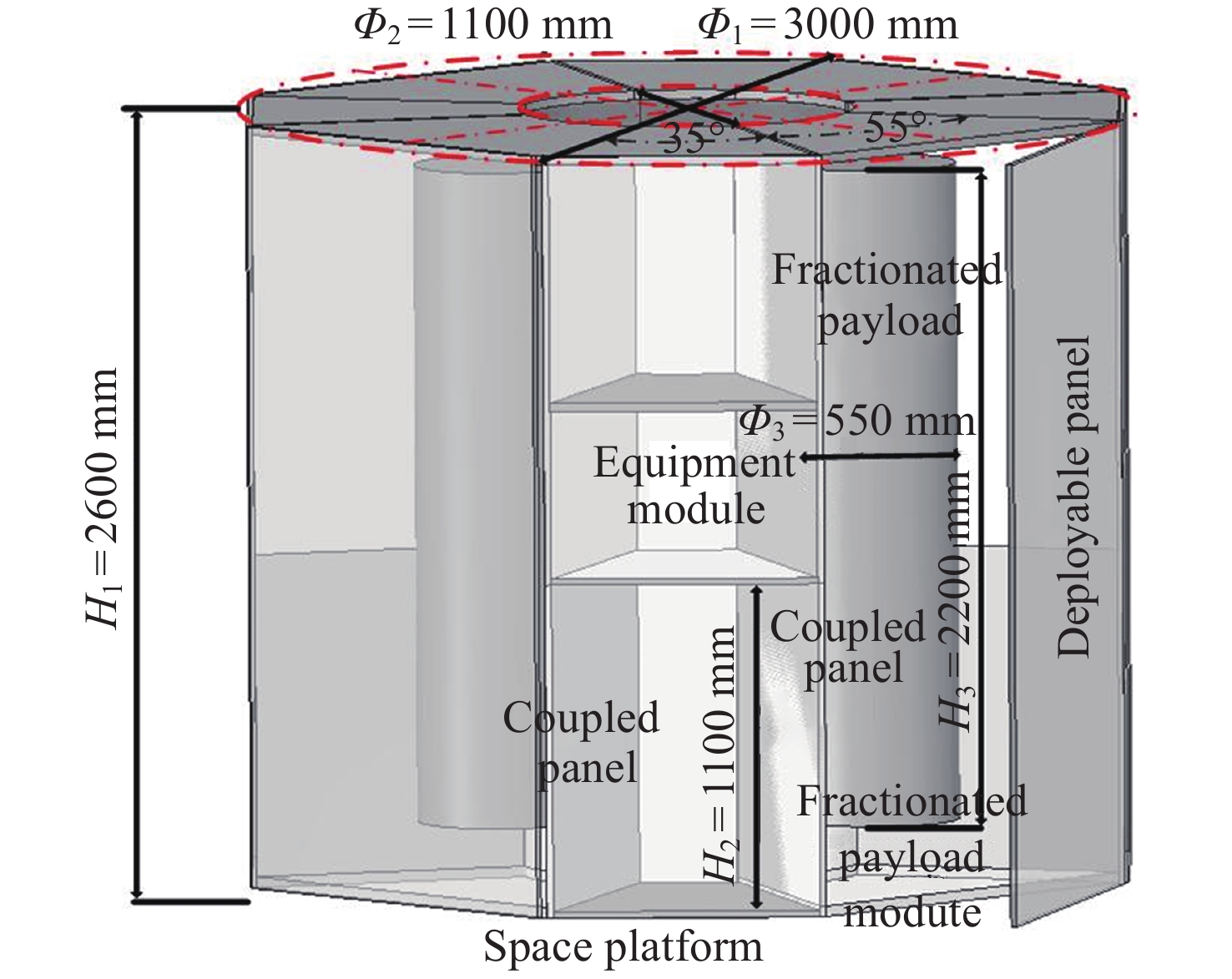Integrated Thermal Control System for Space Platform and Fractionated Payload
-
摘要: 随着航天探索需求发展, 对组合式航天器通过空间平台在轨完成释放,分离出有效载荷或舱段来实现更复杂功能的需求愈加迫切. 空间平台为分离前舱段或载荷提供服务保障. 在假设的空间平台和分离式载荷条件下, 提出一种空间平台与分离式载荷一体化热控设计, 进行热控方案设计, 并对载荷存储控温、载荷与平台互相影响、分离时平台温度变化进行热仿真, 同时开展初步热真空试验, 验证稳态工况下热设计的正确性, 并校正热模型以开展更多工况的分析. 通过热试验和仿真获得了该设计的温度特性和热量传递特性, 数据分析表明该设计合理有效, 验证了热耦合的载荷和平台进行独立热试验方法的可行性, 可为此类航天器热控制提供依据.Abstract: With the development of space exploration, combined spacecraft which can implement more complicated targets through fractionated payload or part of the spacecraft separated from the space platform have been in urgent need. Space platform provides carriage service for the fractionated payload or part of the spacecraft before separation. Under the hypothetical space platform and fractionated payload conditions, the paper proposed an integrated thermal control system for it, simultaneously, simulations of several cases such as thermal control efficacy for the payload during storage stage, the thermal impact between the space platform and the fractionated payload, and the temperature variation of the platform during separation were carried out. Moreover, the steady-state simulations and thermal mathematic model were verified through thermal vacuum test. Thermal simulations and thermal vacuum tests generate the scheme characters of the temperature and thermal fluxes between the platform and fractioned payload. The whole figures of the simulations and test results proved the rationality and effectiveness of the system, meanwhile, verified the feasibility of the thermal vacuum test method for the thermal coupled space platform and fractioned payload while would be independent during thermal vacuum test, which can be as a reference of such spacecraft cases.
-
Key words:
- Space platform /
- Fractionated /
- Integrated /
- Thermal control
-
表 1 试验结果与仿真结果的对比
Table 1. Comparison between experimental results and simulation values
序号 名称 低温环境/℃ 高温环境/℃ 试验值 仿真值(定温) 试验值 仿真值(定温) 1 共用舱板1 –2.7~2.8 0 18.8~23.7 22 2 共用舱板2 –1.3~2.9 0 21.2~29.5 25 3 可开合舱板 –8.5~11.3 –11.6~8.2 –0.1~18.1 –2.1~17.4 4 载荷上半部分 –2.0~7.2 0~6.8 5.2~12.1 7.0~11.8 5 载荷下半部分 –1.7~6.0 –0.8~2.9 13.4~20.1 14.4~20.2 表 2 载荷在平台内工作时对平台的影响
Table 2. Effects of payload working to the platform
工况 共用舱板1平均
温度增量/℃共用舱板2平均
温度增量/℃共用舱板向边界
传递热流增量/WT=–30℃, ξ=1.0 4.8 4.7 39.5 T=–20℃, ξ=0.3 9.0 8.9 16.1 T=–20℃, ξ=1.0 4.7 4.4 37.4 T=0℃, ξ=0.1 18.3 18.2 21.3 T=0℃, ξ=1.0 4.9 4.9 49.6 T=10℃, ξ=1.0 4.8 4.9 46.7 -
[1] 刘赛, 徐世杰. 组合式航天器分离后姿态控制器设计[J]. 空间控制技术与应用, 2009, 35(2): 35-37,45 doi: 10.3969/j.issn.1674-1579.2009.02.007LIU Sai, XU Shiji. Attitude controller design for combined spacecraft after separation[J]. Aerospace Control and Application, 2009, 35(2): 35-37,45 doi: 10.3969/j.issn.1674-1579.2009.02.007 [2] 刘永健, 谭春林, 刘育强. 空间平台能力发展趋势分析[J]. 航天器工程, 2011, 20(2): 72-77 doi: 10.3969/j.issn.1673-8748.2011.02.013LIU Yongjian, TAN Chunlin, LIU Yuqiang. Analysis of space platform capability development tendency[J]. Spacecraft Engineering, 2011, 20(2): 72-77 doi: 10.3969/j.issn.1673-8748.2011.02.013 [3] FOSNESS E R, BUCKLEY S J, GAMMILL W F. Deployment and release devices efforts at the air force research laboratory space vehicles directorate[C]//Proceedings of AIAA Space 2001 Conference and Exposition. Albuquerque: AIAA, 2001: 1-6 [4] FRAUENHOLZ R B, BHAT R S, CHESLEY S R C, et al. Deep impact navigation system performance[J]. Journal of Spacecraft and Rockets, 2008, 45(1): 39-56 doi: 10.2514/1.24310 [5] 舒燕, 李志. 在轨释放、分离载荷动力学仿真研究[J]. 航天器环境工程, 2012, 29(1): 18-22 doi: 10.3969/j.issn.1673-1379.2012.01.004SHU Yan, LI Zhi. Dynamics simulation of on-orbit release and separation of payload[J]. Spacecraft Environment Engineering, 2012, 29(1): 18-22 doi: 10.3969/j.issn.1673-1379.2012.01.004 [6] 张伟, 方宝东, 成玫, 等. 空间飞行器分离式构型设计[J]. 上海航天, 2013, 30(1): 1-7,23ZHANG Wei, FANG Baodong, CHENG Mei, et al. Design of separation configuration for spacecraft[J]. Aerospace Shanghai, 2013, 30(1): 1-7,23 [7] 宁献文, 蒋凡, 张栋, 等. 月球无人采样返回探测器一体化热管理方案[J]. 航天器环境工程, 2017, 34(6): 598-603 doi: 10.3969/j.issn.1673-1379.2017.06.005NING Xianwen, JIANG Fan, ZHANG Dong, et al. An integrated thermal management scheme for lunar robotic sampling and return probe[J]. Spacecraft Environment Engineering, 2017, 34(6): 598-603 doi: 10.3969/j.issn.1673-1379.2017.06.005 [8] (宁献文, 苏生, 陈阳, 等. 月地高速再入返回器热控设计及实现[J]. 中国科学: 技术科学, 2015, 45(2): 145-150 doi: 10.1360/N092014-00475NING Xianwen, SU Sheng, CHEN Yang, et al. Design and implementation of circumlunar return and reentry spacecraft thermal control system[J]. Scientia Sinica Technologica, 2015, 45(2): 145-150 doi: 10.1360/N092014-00475 [9] 刘自军, 向艳超, 斯东波, 等. 嫦娥三号探测器热控系统设计与验证[J]. 中国科学: 技术科学, 2014, 44(4): 353-360 doi: 10.1360/092014-40LIU Zijun, XIANG Yanchao, SI Dongbo, et al. Design and verification of thermal control system for Chang'E-3 probe[J]. Scientia Sinica:Technologica, 2014, 44(4): 353-360 doi: 10.1360/092014-40 [10] 陈江平, 黄家荣, 范宇峰, 等. “阿波罗”登月飞行器热控系统方案概述[J]. 载人航天, 2012, 18(1): 40-47 doi: 10.3969/j.issn.1674-5825.2012.01.008CHEN Jiangping, HUANG Jiarong, FAN Yufeng, et al. An overview on thermal control system design of Apollo[J]. Manned Spaceflight, 2012, 18(1): 40-47 doi: 10.3969/j.issn.1674-5825.2012.01.008 [11] 苗建印, 钟奇, 赵啟伟, 等. 航天器热控制技术[M]. 北京: 北京理工大学出版社, 2018: 317-326MIAO Jianyin, ZHONG Qi, ZHAO Qiwei, et al. Spacecraft Thermal Control Technology[M]. Beijing: Beijing Institute of Technology Press, 2018: 317-326 -
-





 吴自帅:男, 1985年5月出生于河南省濮阳市. 现为上海卫星工程研究所热控设计师、高工, 主要研究方向为空间飞行器热控设计和工程研制. E-mail:
吴自帅:男, 1985年5月出生于河南省濮阳市. 现为上海卫星工程研究所热控设计师、高工, 主要研究方向为空间飞行器热控设计和工程研制. E-mail: 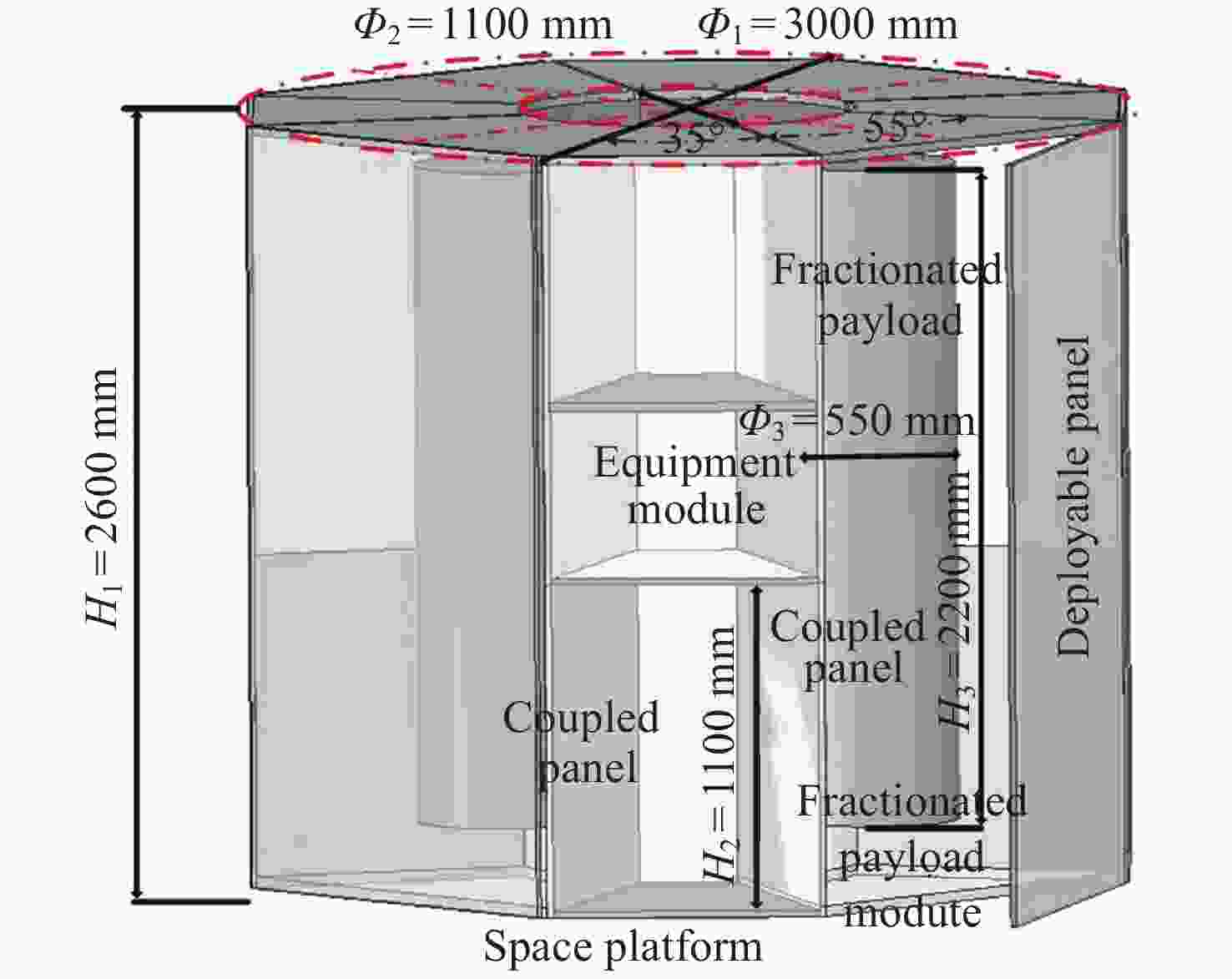
 下载:
下载:
